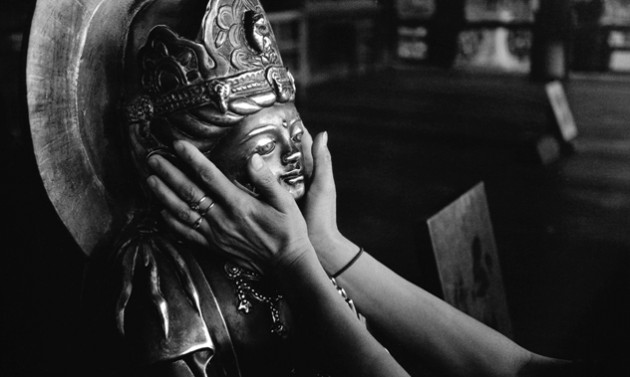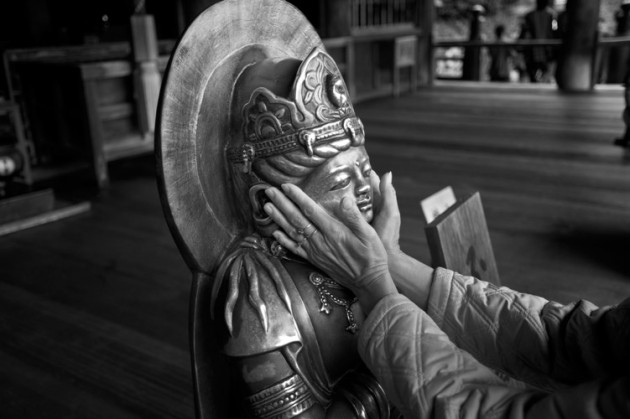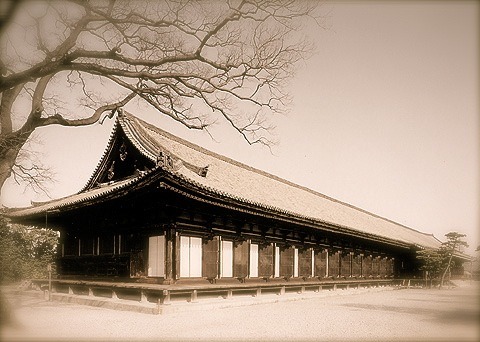
“Dreams say what they mean, but they don’t say it in daytime language”
~Gail Godwin
[W]hen people ask why I came to live in Japan, I sometimes tell them that Japan first came to live in me; that my physical journey here in 1984 was merely an overdue affirmation of this.
It all began in 1980, when I was 29, with the first of a series of vivid dreams. These occurred at dawn and continued through four summer mornings. I would find myself in an unfamiliar yet comfortable foreign land, with men, women and kids whom I cared for, yet could not upon waking recall ever having met. In these dreams whole days would go by. I was happy, in love and engrossed in my work — a far cry from my waking hours, where a foundering marriage and indecisive career were all I seemed able to manage.
It’s long ago now, and details of those daybreak dreams have faded. At the time, though, they were compelling for the clarity with which I recalled them. After all, for most of us most of the time, dreams are fleeting, fugitive things. These were noteworthy for one more reason. In them I often conversed, if haltingly, in Japanese, a language I had seldom even heard.

WHEN THE DREAMS CEASED, a yearning grew within me to leave California and travel to Kyoto, which somehow I knew had been their setting. But my American life, for all its shortcomings, had trappings as well. I indulged myself instead by talking with friends about a future journey, and became a Japanophile — Kurosawa and Ozu films, koto concerts, otsukimi moon-viewing in the city park, books on bonsai and history, cherry blossom festivals in San Francisco’s Japantown. I ate yakitori and green tea ice cream, and evenings after work I even took a Japanese language course. Then one summer afternoon, three years into all this, while grilling chicken at a barbecue in my friend Jim’s backyard, I was blathering as usual about going to Japan when Jim, who had studied Chinese at Beijing University, unexpectedly grew sullen. “Stewart,” he said in a tone of exasperation. “Just answer me one question, will you? Just one?”
Stammering, I said that I would.
“Do you even have a god-damned passport?”
A SHEEPISH WEEK LATER I did, and its blank pages now beckoned invitingly. Even so, it took another year to plan my departure and go. A few days before flying I phoned up Stephen, an old college friend I hadn’t seen for a year or so. To my surprise, he implored me to meet him; he had something to show me about past-life regressions. I needed, he said, to learn about one of my own.
During our lunch at a busy Chinese restaurant, Stephen flipped through a two-inch stack of index cards that held, he said, notes of his own past lives. I listened skeptically, but intrigued by how my erstwhile stockbroker pal could ever have gotten himself wrapped up in something so cabalistic. After the meal, we walked back to my house, sat down in a pair of sofa chairs and got started on me. I was relieved there was no “New Age” ritual. Stephen began by asking whether I had recurring dreams. I recounted the two most frequent.
In one, I’m surrounded by pitch darkness, trying to get to a distant building that is all aflame, but my feet are leaden. The near-paralysis fills me with anguish. In the second dream, it’s a sunny day and, in a seated position a foot or two off the ground I whisk myself anywhere I wish to go. This hover-flight seems natural. Whenever I awake from this dream I’m bewildered that I have somehow lost what so unmistakably felt like an inborn ability.
“For now,” Stephen instructed, “enter the space of that second dream.” Closing my eyes, I did so, surprised by the ease of a technique it had never occurred to me to try.
“Now open your eyes; look around you there. What do you see?” Almost immediately, a bare, tanned shoulder moved before me, part of an entire virtual scene that was somehow superimposed on my living room, also still clearly visible. In this waking dream I was riding inside a basketwork palanquin, borne by two nearly unclad men, my seated form moving along a foot or two above a flagstone path, heading toward a Japanese-style building that appeared to be a temple. I told this to Stephen. Answers to his questions appeared at once.
“Where are you?” In Kyoto.
“When?” Thirteenth century. . . around 1248, or 49 . . .
“Who were you then?” On this I drew a blank.
“All right, keep moving along that stone path.”
I did so another few moments.
“What now?”
The two men in loincloths had carried me to the temple entrance. I climbed out of the palanquin and slid the front door open myself, all of this happening in pictures while I sat motionless, facing Stephen.
Entering I found an austere, shadowy anteroom decorated mainly with a pair of very tall, slender vases of blue and white porcelain. One had a cracked portion at the top where repairs had been made, on the rim.
“Now draw your attention away from yourself just far enough to look back and see your own face.” This peculiar request was also easy to carry out. I now saw a man with high cheekbones and a feathery moustache, whose mournful face conjured up painful grief and a montage of recollections.
“I was an aristocrat who became a priest. . . unable to be with the woman I wanted . . caught between my devotion to life in the worship hall and another life that I yearned for in the performing arts, where this woman lived hers. . . I’m watching her dance now at night on an outdoor stage, lighted by torches. . . but all this longing is out of the question for someone like me.” Then I peered straight into the eyes of that man. “I took my own life, some years later,” I said. Stephen nodded knowingly, which rattled me, and the whole mise-en-scene simply vanished from view.
Stephen then pulled out a card from his stack and let me read its penciled notes, about a life which he said he too recalled from 13th century Japan.
WITHIN A COUPLE OF EBULLIENT, eye-opening weeks I had settled into a small tatami room near Kyoto Station, made some friends, joined an expatriate theater troupe, and found a teaching job that left my daytime hours open for exploring. I’d also met Sue, a warmhearted painter ten years my senior who had come from L.A. to Japan to study techniques for restoring ancient painted scrolls.
I would spend the night at Sue’s occasionally, and once, a few hours after we’d fallen asleep, I abruptly awoke from a tormenting nightmare: I’d been enveloped in roaring flames, within which emerged serene faces with eyes like thin crescent moons.
“You were shouting,” Sue told me, “‘Sanjusangen-do!’ over and over.”
I had no idea what the word meant. Sue explained that it was a temple not far from her place that sheltered a thousand statues of Kannon bodhisattva — deities of compassion. Would I like to go there in the morning? Yes, I answered, and we drifted back to sleep.
RAIN CLOUDS SPREAD OVER KYOTO, dimming the interior of the worship hall as we shuffled inside in our stocking feet. Turning right to skirt what looked like the side of a grandstand, with the hall’s paper-windowed shoji glowing softly at our backs, we were suddenly face to face with an immense crowd of time-weathered, life-sized golden figures standing in rising ranks ten columns deep and seeming to stretch on forever.
Each Kannon had dozens of arms, with delicate hands that nearly all held objects — a vial, an arrow, a set of rings, a bell, a scepter, a lotus bud. Two hands were joined in front, palms pressed together in prayer. The eyes in their tranquil faces were barely open. And each figure was crowned with several smaller heads and a halo.
I gazed at their faces, awestruck, lingering longer on some than on others. “Familiar?” Sue asked in a whisper. And yes, she was right, they were, but not only from my dream: A few of the faces — each was distinctive — reminded me of people I knew back home. Folk belief holds that anybody can find such faces in the throng.
The androgynous, serene Kannon brought to mind the myth from Plato’s Symposium: that humans were hermaphrodites until split in two by God, since which time, mere halves, we have wandered the world in search of a partner to make us whole again — the root of the longing we know as love. The Kannon here seemed enviably peaceful legions beyond desire.
As we made our way slowly along the worn wooden floor, down the deep hall, coming before the large, principal Kannon seated centrally on a lotus blossom seven petals high, I was increasingly torn between feelings of reverence and a resistance based in a core precept of my Jewish upbringing: the ban on worshipping idols. But the reverence was overpowering, and as I let go and inhaled the incense smoldering near this largest statue I also felt, welling inside, an achingly mournful sadness.
I paused to gather myself at a counter nearby where booklets, cards and amulets were sold, and purchased a picturebook guide. An hour later, over a bowl of rice, I would read that this massive temple, founded in 1164, had burned to the ground in 1249. Priests had risked their lives by running into the flames to save as many of the thousand Kannon as they could. In all, 124 had been spared. The rest were reduced to ashes and cinders, and it had taken a team of Buddhist sculptors led by the master Tankei 17 years to carve and gild anew the figures which have stood in the rebuilt sanctuary ever since.
SUE FLEW HOME. By now divorced, I stayed on in Kyoto, and then met Etsuko, urbane and gregarious, born in the rice-growing town of Sasayama. We married and soon had a daughter, and I grew ever more devoted to family, friends and students in Japan. I wrote for newspapers and magazines, took up photography, poked around in rustic villages. And I seldom gave further thought to the strange occurrences told above. They seemed immaterial now, except perhaps when I’d take a visiting friend or relative to view the marvels at Sanjusangen-do.
Years sailed by. Then one morning in early spring I awoke from a dream that I hungered for more of, yet could not even recall — a total blank, aside from knowing that this was the day to visit a well-known Kyoto temple I hadn’t yet gone to see.

WE WERE IN AN OPEN CORRIDOR linking one temple building to another. My wife Etsuko had meandered ahead while I was looking intently at a folding screen covered with ancient, fan-shaped paintings. When at last I turned to move on, I saw her standing in profile peering into a glassed-in display. I approached but still was unable to make out what was inside, for the angle was acute and the floor-to-ceiling panes reflected the sunny Zen garden outside. Yet as I drew closer I felt a painful tightening in my chest, and it took a moment to comprehend that here again was that grief and anguish, which seemed to have no reason at all for congealing in that moment.
I reached the display; it held a palanquin, basketwoven and faded to a dirty gray. I was startled, confused, in pain, but didn’t want to break the quiet flow of our outing by blurting out my dubious, self-centered tale, most of which I had never yet shared with my wife. So I steadied myself and asked her to read the little wooden sign at the bottom.
“This priests’ kago dates back to the thirteenth century.”
Silent but reeling, I stepped away toward another display nearby. And there inside were a pair of tall, slender vases of blue and white porcelain, one with a crack repaired on its rim. My knees buckled. I started to sob. Etsuko wrapped an arm around my shoulders and urged me to tell her what on earth was the matter. We retreated to a tea room in the temple, where, still stunned, I did the best I could.
THAT WAS EIGHT OR NINE YEARS AGO. I’ve often thought since about the path I have followed through a corridor of dreams, sometimes looking backward to the distant past; at other times, ahead to the future. While inside of these dreams, however, the time for me has always been now.
Some suggest that we each have immutable souls which pass from one life on to the next. We have, they say, mistakes to correct, lessons to learn and to teach. Others assert that we’re given but one precious incarnation in which to do our changing and learning. Somehow, in light of my experiences, I feel both of these standpoints hold truths which are partially clouded by illusion, that neither has it quite whole. For while spirit seems to pass on, nothing — not even this — is immutable.
It is change itself which makes everything precious.
Paradoxically, the more I have felt the life and death of that sad Kyoto priest echo through my days and nights, the less have I sensed any claim to him. Tasting his grief, coming face to face with artifacts from his life, I’ve begun to see instead that I do not own this lifetime either. I’m grateful beyond measure for this borrowed existence. But, like the priest’s, my life will end. And like his, mine may well reverberate someday in the heart of another. After all, this happens every day between friends, enemies, students, teachers, family and lovers whose lives overlap in time. Why, then, should eras stand as barriers between us, if truly there is unity of the one and the many? As a dreamer, perhaps I have simply needed more sleep than most to awaken to the illusion of the separate self. I take heart in the words of the Dalai Lama, who says that sleep is the best meditation.
